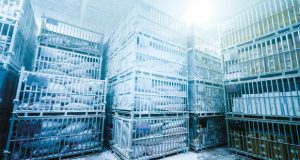Simon Slade, Principal Technologist at Pilkington UK, discusses the role of glass and glazing in making buildings more bird-friendly
 Bird protection is becoming an important consideration in building design. Some estimates suggest that collisions with buildings are responsible for the deaths of up to a billion birds each year – with 100 million birds affected by collisions in the UK alone.
Bird protection is becoming an important consideration in building design. Some estimates suggest that collisions with buildings are responsible for the deaths of up to a billion birds each year – with 100 million birds affected by collisions in the UK alone.
So far, the UK has been relatively slow to adopt bird-safe building regulations, with the result that many buildings don’t have bird-friendly measures installed. However, a flurry of recent developments around the globe shows that the issue of birds striking buildings is beginning to attract the attention it should. A key example of this was the Bird-Safe Buildings Act introduced in the US Congress last January, which requires all public buildings under construction to feature bird-safe building materials and designs when possible.
Given these recent developments, there is a strong chance that similar regulations may begin to make their way to the UK, so FMs should give serious thought to bird-friendliness as a design factor when it comes to recommending building upgrades. Estimates suggest that incorporating bird-friendly design measures can reduce bird deaths caused by collisions by up to 90 per cent.
FMs can influence external factors affecting how many birds strike buildings, such as lighting or strategically placed potted plants throughout the building. However, as glass continues to make up more of the external building envelope and is a key part of the problem, it’s clear that FMs should consider the glazing specified for a building as a longer-term bird-safety solution.
A commonly held misconception is that birds collide with glass because of poor eyesight. In fact, many birds have fantastic eyesight. The main reason that birds fly into glass is that they mistake sky, trees, and other habitat features reflected in the glass for reality. Birds will also sometimes try to fly through glass to something they see on the other side, once again causing them to collide with the glass surface.
Interestingly, this issue isn’t just restricted to birds. Humans often only ‘see’ glass by being aware of frames or the vertical bar between the panes of glass in a window, which is why we might collide with unmarked glass doors if we’re not paying proper attention.
Aside from the obvious ethical considerations of ensuring the built environment is as safe for birds as it can be, not taking steps to protect local bird populations can cost businesses time and money. When a bird collides with a window, it often leaves an unsightly print on the glass. Not only does this compromise views from inside the building, it also necessitates more frequent window cleaning, increasing maintenance costs. This is a particular issue for FMs who look after high-rise commercial developments, where higher-placed windows are more difficult to reach and clean unless advanced ‘self-cleaning’ glass is specified.
Any birds that fall to the ground following collisions will need to be cleared away. Dead birds around a building are not only unsightly and distressing to passers-by, but birds that are not removed can rot quickly, especially as we approach the warmer summer months, risking the spread of disease. Dead birds can also attract foxes, stray cats and even pests such as flies and rats, making buildings even less attractive and more susceptible to germs. This can in turn lead to increased expenditure on pest control.
PREVENTING BIRD COLLISIONS
While the field of bird-safe glass is still in its infancy, the technology is developing rapidly. A recent architectural bird-safety success story that made international headlines was New York’s Javits Centre – a 760,000 sq ft exhibition hall made almost entirely of glass. Previously responsible for the most bird deaths each year in New York, the building was renovated to incorporate dotted glass across its façade. By creating a visible ‘barrier’ for birds to avoid, this measure has reduced bird collisions by 95 per cent.
While dotted glass products such as this are effective, they can reduce the transmission of natural light through glass and affect views from inside the building. However, recent advances in glazing mean that bird populations can be safeguarded without compromising in these areas.
Specialised bird-friendly glass uses an ultraviolet (UV) enhanced patterned coating to break up the reflectivity of the glass surface. Because many birds see the world through UV rays of varying wavelengths virtually invisible to the human eye, the coating creates a visible barrier for birds to avoid with limited effect on the window’s visibility for humans. Because birds will not attempt to fly through spaces less than two inches high and four inches wide, the patterns applied to bird-safe glass will be spaced no wider than this.
Bird-safe coatings can be used alongside other glazing technologies to offer additional benefits. For example, advanced glass that offers both bird-safe and solar control properties is currently in development, which will minimise bird strikes while reflecting away much of the sun’s heat.
FMs, as key decision-makers in the maintenance and renovation of buildings, have an integral role to play in making the built environment more bird-friendly. With the right products and knowledge in place, it’s possible to ensure that the built environment can co-exist with the natural world and the creatures that inhabit it.




